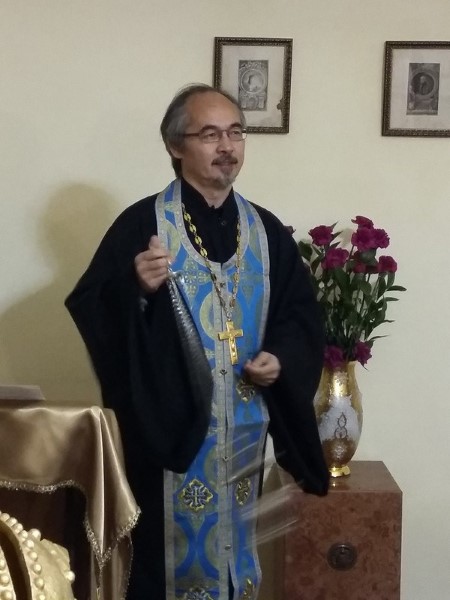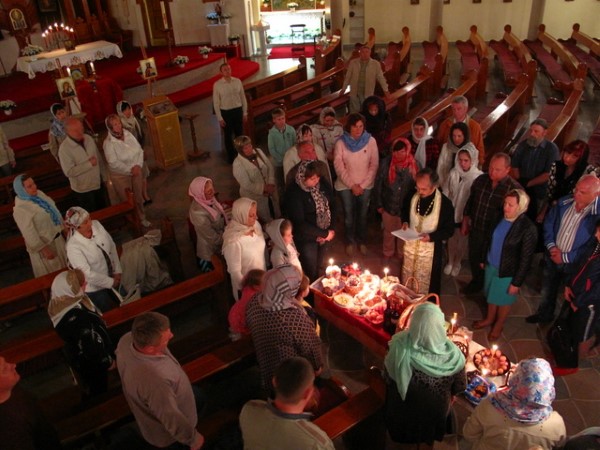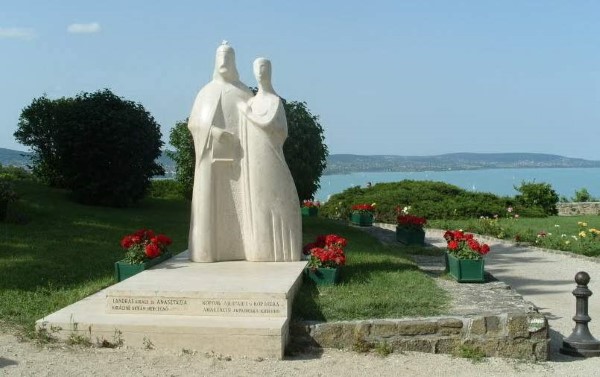Russian speech may be heard in a small Hungarian resort town Heviz even more often, that Hungarian. Thus, the news about building a church for a recently created parish, which came at the end of the previous year, was not surprising. Father Nikolay (Kim), born in St. Petersburg, has lived and served in Hungary since 2000 and was named its rector.
‒ Father Nikolay, we are now holding our conversation at a church, which does not seem to be quite orthodox….
Orthodox service on Easter day in Heviz (2013). Photo from personal website of Father Nikolay Kim
‒ Indeed, it is a catholic church in the name of the Holy Spirit, built quite recently – at the end of 20th century. But Catholics give us an opportunity to service here. Even when catholic and orthodox Easter dates match, there is no problem – the catholic service ends right when our service starts. In this sense, Heviz is an exceptionally tolerant and hospitable town to all the confessions and nationalities.
‒ All in all, what is Heviz?
‒ A small town with only four thousand inhabitants is a famous year-round balneotherapeutic health resort, which is the most popular one in Hungary. Its main attraction is located in the city centre and it is a unique thermal crater lake, which is the second largest in the world and the only one in Europe.
It lives on very powerful underground springs and is about 30 degrees warm throughout the year. Mineral water of this lake has astonishing healing properties; it can heal numerous diseases of locomotor system, such as podagral, for example.
These properties show the most vividly on the Epiphany day, when its waters are blessed – one does not have to immerse into the ice-cool water! This is why the popularity of Heviz is growing year by year and we are having more and more Russian-speaking patients, including our compatriots. Many have already or are buying houses here.
This is why the Holy Synod of the Russian Orthodox Church decided to establish a Russian orthodox parish here at the end of 2012. Quite naturally, it was named in honour of the Holy Virgin icon “Life-Giving Spring”; last year, it was decided to build a church here.
‒ Meanwhile, Hungary is not considered to be quite orthodox, still…
‒ Which is wrong! Although, the history of Christianity in Hungary is – metaphorically speaking – not a straight line, but a chain of several vivid flashes. One can meet signs of the first of them near the Heviz Sármellék airport, which opened again recently because of the rising number of tourists – for instance, flights from Moscow are going to be done every week this summer.
It is a blessing of the great saints - Saints Cyril and Methodius equal to the Apostles. A place called Zalavar, which is five kilometres away from the airport, is known thanks to the archeologists, who have recently found pottery fragments with the most ancient Glagolitic script on them.
It can be declared quite surely, that in the middle of the 9th century, the mission of Saints Cyril and Methodius for the Slavic people began right there – from Zalavar, where an ancient Moravian city Blatnograd used to be. Please notice that it was even before the descendants of the current Hungarians inhabited the Pannonian Plain. Today in Zalavar, there is a monument to Cyril and Methodius from Bulgaria and Slovakia.
Near it, there is a temple built in the ancient Roman style; on the SS. Cyril and Methodius Day, our parish services in it and we pray for all our compatriots in the Balaton region.
‒ On the Tihany Peninsula, near the Benedictines Monastery, which is also not far away from here, I saw a memorial to the daughter of Yaroslav the Wise, Princess Anastasia…
‒ It is known, that Anna Yaroslavna was the Queen of France. Anastasia Yaroslavna got married to the King of the first Hungarian Arpads dynasty, to Andrassy I – he is buried at the monastery. Orthodox monks came to Hungary from Kiev with Anastasia. They established a skete inside the caves of the Tihany hillsides – a peculiar kind of a Hungarian “Mount Athos”. These ascetics are now considered the founders of the Benedictine monastery. A monument to Arpad and Anastasia has been recently erected near it.
Monument to Andrassy I and Princess Anastasia Yaroslavna
– When was the next “flash”?
– It was during Peter the Great – he tasted Tokay wines during one of his journeys across Europe and enjoyed them very much. In 1714, a Tokay Commission for purchasing wines for the Emperor’s court was established according to the imperial ruling; gradually, a Russian colony emerged in Tokay. And together with it – it is clear – a church; a family chapel at first, and then a church made of stone, which exists even now. Its acolyte was a great Ukrainian sophist Grigoriy Skovoroda. Today, it is a museum, but there are orthodox services every year during St. Nicholas Days.
– As far as I know, the church you were servicing at before Heviz, is also connected with the imperial family…
– Yes, it is a Church of the Saint Queen Aleksandra in the Üröm village. It is a chapel of Katherine the Greats’ granddaughter - Great Princess Aleksandra Pavlovna, who was married to Archduke Iosif Gabsburg, the Hungarian sovereign. She died of puerperal fever, having lived for only a year and a half in Hungary up to then. But even within this short period, she was able to win sincere affection of the Hungarian people.

As a person of the imperial family, she was supposed to be timelessly remembered in prayers; thus, a small orthodox chapel was built on basis of the Austrian court architect Heppe’s project over her tomb. The chapel was blessed in 1803. Many members of the Russian imperial family were there. Its crowning glory is a well-preserved icon-stand, made by academician Vasilyev; it was given as a gift by Aleksander III in 1883.
After the 1917 Revolution and till his death in 1926, Archpriest Stephan Kolumbov served there. After that, the church began falling into decay, but was not closed. Local inhabitants maintained good order in the church as best as they could for all the 20th and the orthodox priests from Budapest – not only Russian, but also Serbian and Hungarian – served there on the most memorable dates. By the grace of God, we started restoring and renovating it in 2002 and today, the church has its full spiritual life. In 2004, the future Patriarch Kirill visited it – then he was the Smolensk and Kaliningrad Metropolite.
– Has the 21st century been remarkable for the Hungarian orthodoxy?
– Yes, there is a famous among tourist ancient city Szentendre near Budapest, where the first round table discussion of the Patriarchate of Moscow and the Russian Orthodox Church Outside Russia was held in at the end of 2001. It started the historic process of their reconcilement. It was held and supported by a man, who can be considered a real saint of our time – Serbian Archbishop Daniil (Krstic). Thanks to his unquestioned spiritual authority, deep humbleness and sincere love to Russia, this discussion was held!
– What the Holy Virgin Icon “Life-Giving Spring” Church in Heviz will be like?
– It will be the only Orthodox Church in Western Hungary, it will be built this year in the park territory of one of the best hotels in Heviz – the highest place of the town. The author of the project is a very famous Hungarian architect, winner of numerous Laszlo Vance prizes, who tried to combine the traditions of Russian, Ukrainian and Hungarian Templar architecture.
The sizes of the church are 11 x 13 metres, it is 18 metres high together with a gilded dome. The base will be made of stone and the upper part – of wood. The church will have side exits, lofts, a small bell-tower will be placed at the top, outer icons will be painted on the four walls of the church in the colour glaze technique.
The choice of the icons will remind of the Church’s name, that it is standing on the land of Saints Cyril and Methodius, about the joint spiritual source of the Russian and Hungarian history. This is why, apart from the Holy Virgin Icon “Life-Giving Spring”, the walls of the Church will be painted in icons of the saint teachers of the Slavic people, the blessed Vladimir the Great and Hungarian King Istvan.










